Questionto keep this short & sweet..dog dug up nest of wild infant rabbits, all ok except one had a skin tear on it's back. Eyes closed when we found him, put the others back in the nest & they are all doing well. Treating the injured baby, feeding KMR w/ 3 drops pediatric vitamins, (gave pedialite at first few feedings) added acidophilus a bit of whipping cream and he has done quite well. Back is healing too, I am using TAO every few hours. I have had him 6 days and find it a miracle that he is still with me. I know the odds are not good. We are now at that transition stage where he is taking less formula and eating small amounts of organic baby romain leaves, a touch of apple, not interested yet in hay or whole oats. Drinking water out of a small jar lid at times. He is eating but how much should he be eating and how frequently? In short.. the article you spoke to other people about ( that was too long to post) may I please read it? No rehabbers want him and I will not let him die without doing everything in my power. Any advise will be very much appreciated. (I have a 10 year old dwarf house bun as well..best bunny in the world..ya gotta love those buns) Thanks for your wonderful contributions to the bun world.
AnswerIf a rabbit becomes bloated, put the lower half of its body (up to its
waist) in warm water, and gently massage its stomach for about 5 minutes.
Dry very carefully, and return the rabbit to the nesting box. Do not chill.
Within a couple of hours, the bloat should disappear. If the bloat
continues, alternate regular feedings of formula with a feeding using
hydrating solution. Contact your supervisor if the bloat continues unabated
for more than 24 hours.
The color of rabbit's urine can vary. It's not unusual for wild rabbits to
have very dark, rusty colored urine.
When the eyes are open, continue adding lots of fresh clover, slices of
apple, dandelion greens, Queen Anne's Lace, and wheat germ to the floor of
the box each day. Include the roots and the soil attached to plants you
pick. Grass, because of its low nutritional value, should constitute a
small percentage of the total vegetation. Place some formula in a shallow
jar cap with active-culture yogurt (with berries) in order to help prevent
intestinal bacterial diseases.
Gradually, over a period of several days, eliminate formula feedings as the
rabbits start eating on their own. Although rabbis get some moisture from
the greens, it is advisable to add a small jar cap of water to the box
after weaning. It's not unusual for rabbits to become disinterested in
eating when they first open their eyes. Their preoccupation with their new
surroundings should subside in about a day, and their appetite should
return to normal.
The clover, Queen Anne's Lace, and dandelion greens should be picked twice
a day, morning and evening. Be sure the vegetation is free from any toxic
sprays. Commercial rabbit chow can be added. Eliminate the formula when you
are certain the rabbits are filling up on the natural foods. You may not
actually see them eating, but indications that they are include: seeing
pieces of grass in the corners of their mouths; noticing the difference
between how much natural food put in and how much is left; noticing bites
taken from a piece of apple; recognizing that a rabbit's tummy is rounded
when no formula has been fed for 4 or more hours; and observing
disinterest in formula. If all the greens are consumed, you might not be
feeding enough. Provide enough greens so that there is a small amount left
between feedings.
Self-feeding rabbits often will stop eating if there is any noise in the
room or if they are being observed.
RELEASING
When the rabbits are eating a natural diet and have been acclimatized,
place them in a predator-proof, outside-release cage. Construct the release
cage with wood that hasn't been chemically treated and 1/2-inch hardware
cloth. The wire must be fairly small gauge because rabbits can squeeze
through very small openings. Wire the cage on all sides, including the top
and bottom. Cover the bottom of the cage with soil. Provide the rabbits
with natural landscaping in the cage, such as logs, rocks, branches,
shrubs, etc. Include a smaller nesting box within the larger cage.
To protect the rabbits from excessive sun, rain, and/or wind, either cover
part of the cage with a tarpaulin or construct the cage with a solid top
and two adjoining solid sides. Before releasing, the rabbits must have been
outside, day and night, rain and shine, for at least 5 days. Provide a
large amount of fresh clover, dandelion greens, and Queen Anne's Lace
daily. Be sure the water source is fresh and clean.
Rabbits are vulnerable to heat. They should never be placed in the direct
sun. If your rabbits develop symptoms of heat stroke (act lethargic, feel
hot to the touch, lie in a stretched out position, and are panting), wrap
them in a towel that has been moistened with cool (not cold) water. When
they have recovered, place them in a cooler location. On extremely hot
days, some rehabilitators have placed plastic milk jugs containing water
that has been frozen in the rabbit cage to help alleviate the summer heat.
When the plastic jug is filled with water, make sure that you don't fill it
all the way to the top; the plastic will break when the water freezes if it
doesn't have room to expand. If you have trouble with the milk containers
cracking, try using a square plastic freezer container.
Release the rabbits in a location where there are plenty of grazing areas
plus wooded areas for shelter. Log piles and thick shrubby or thorny
thickets are good release areas. Release away from humans, dogs, cats,
roads, and gardens. Once a rabbit is released, it probably won't come back
to a release site. However, just to be safe, lock the cage door so that the
rabbits don't reenter the cage and become an easy, captive prey for
predators.
An appropriate release age is 3 to 5 weeks. Do not keep healthy rabbits
longer than this. Even though they are not full-grown, they are ready for
release and not do well in captivity after 5 weeks.
Check the weather forecast before releasing the rabbits, and wait for a
prediction of at least 3 days without rain or dramatic drops in temperature.

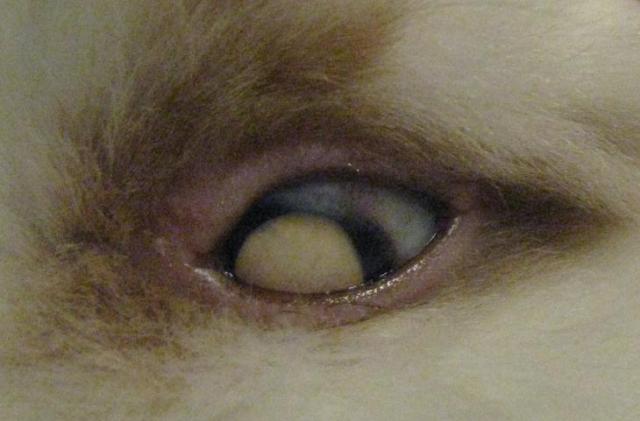 Eye Trouble and Fur Mite treatment
Question
rabbit eye problem
Dear Dr Krempels,
&n
Eye Trouble and Fur Mite treatment
Question
rabbit eye problem
Dear Dr Krempels,
&n
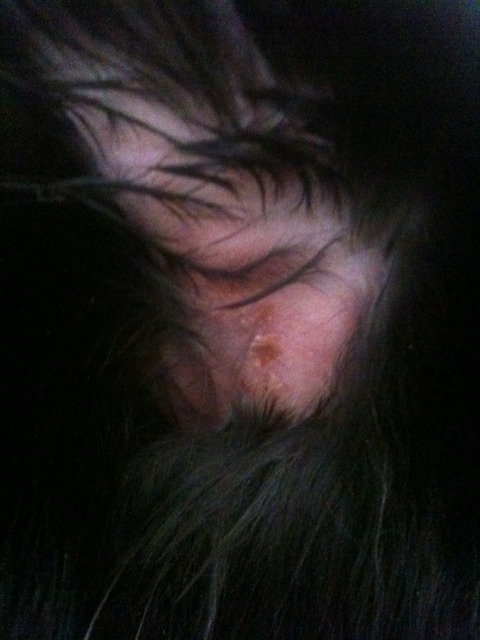 Itching Ears
Question
ear sores
My buck has lately (for at least a m
Itching Ears
Question
ear sores
My buck has lately (for at least a m
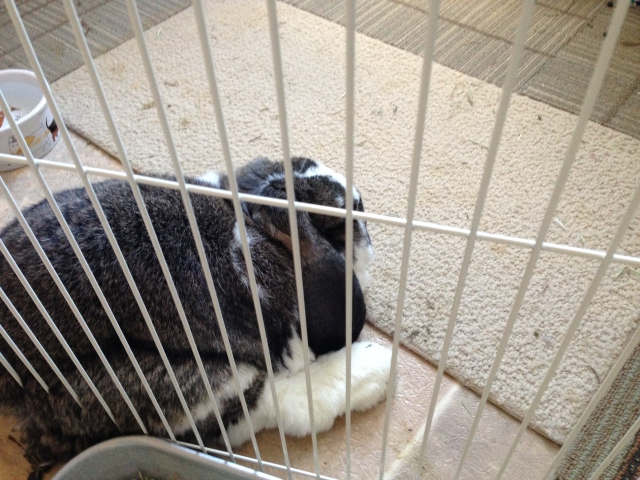 hind end weakness
Question
hind end weakness
Hello Dana,
I apolog
hind end weakness
Question
hind end weakness
Hello Dana,
I apolog
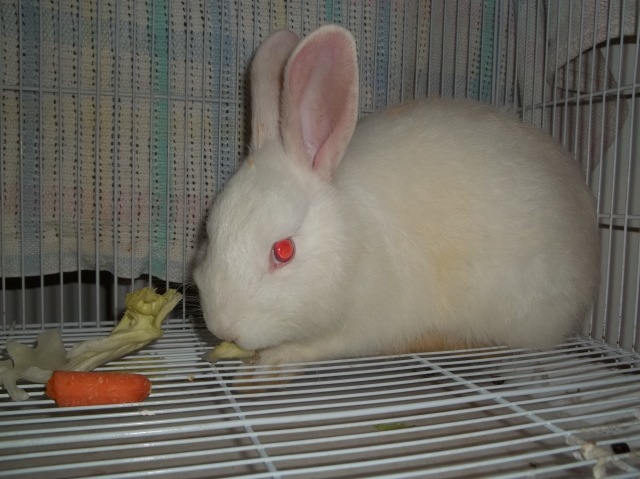 Our new albino rabbit...
Question
Snowball
I just bought my daughter our first r
Our new albino rabbit...
Question
Snowball
I just bought my daughter our first r
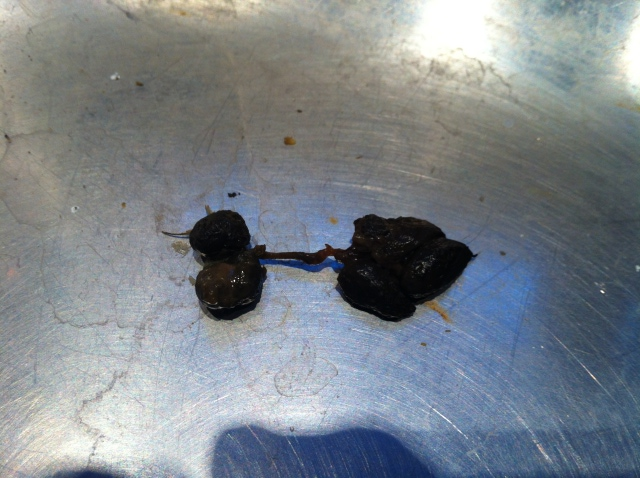 Mucus in droppings
Question
Dropping with mucus Single with mucus st
Mucus in droppings
Question
Dropping with mucus Single with mucus st